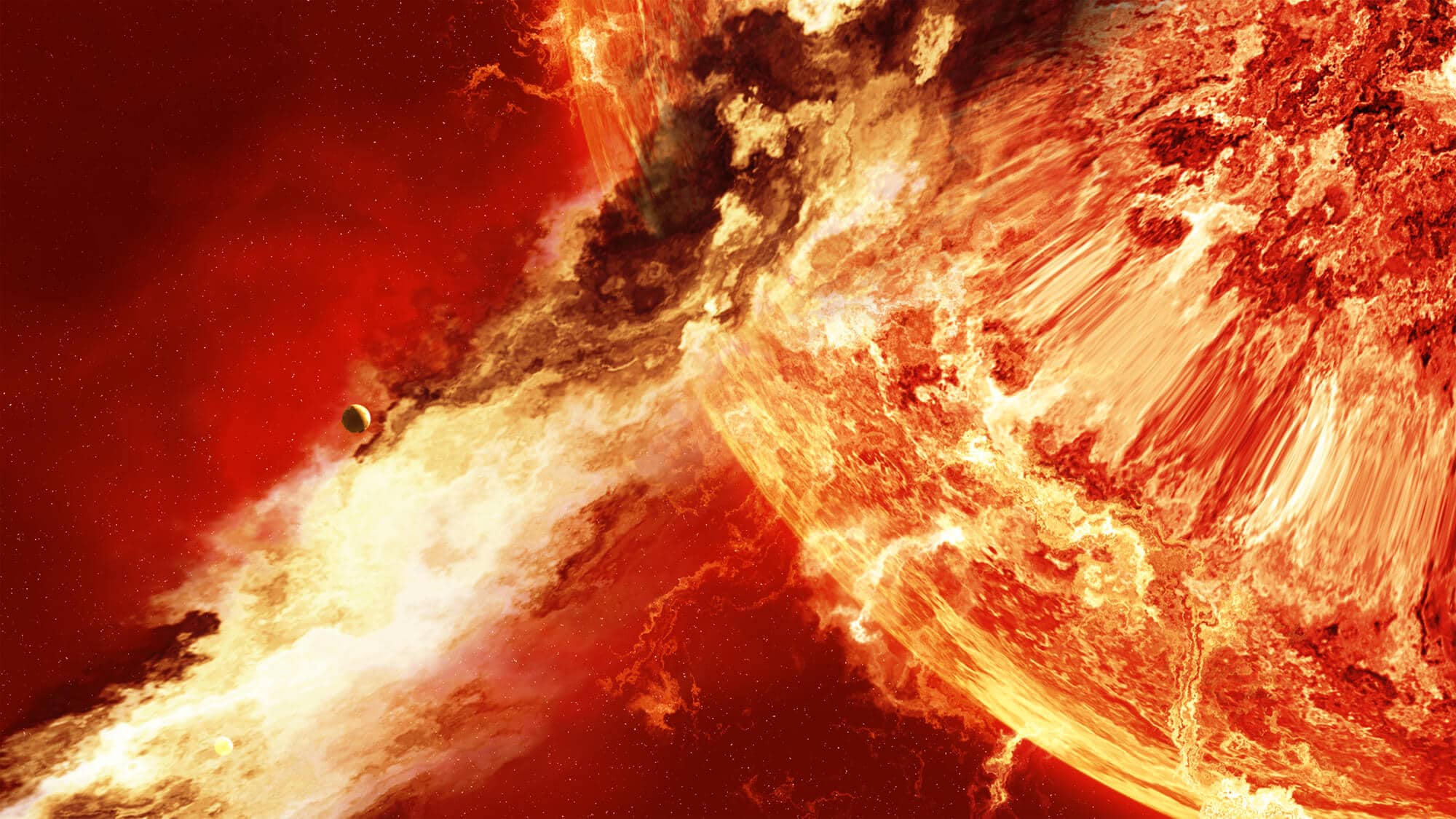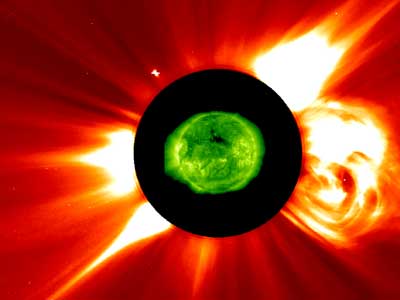An array of spacecraft spread throughout the solar system has given scientists the most complete and up-to-date picture of how solar storm frontal waves propagate in free space and the radiation produced in their wake.
Translation: Alon Zeevi, Israel Astronomical Society.


The solar storms, which took place in October-November of 2003, released into space billions of tons of electrified gas (plasma) which bombarded Earth within a day and passed over Mars a few hours later.
The most recent reports come from the pair of Voyager spacecraft far at the edge of the solar system, an area where the arms of astronomical research have not had time to reach yet.
While traveling to the space outside the planetary system, the solar wind becomes turbulent and "nervous" as it collides with the interstellar gas, and it crosses the boundaries of the heliosphere (Heliosphere) of our solar system. During the last fall, the solar storms sent material into space that "smashed" on top of the Earth at a record speed of 8 million kilometers per hour, passed over it and the other planets and continued on to the individual research spacecraft. The shock wave, which slowed to an average of 2.4 million km/h near the outer boundary of the heliosphere, passed Voyager 2 on April 8 at a distance of 11 billion km from the Sun, and will pass Voyager 1 on 14.5 billion km from the sun.
The aforementioned solar storms are the strongest measured so far: they broke a world record for X-ray intensity, speed and temperature of the solar wind observed near the Earth. Around a third of all the particle radiation (Particle Radiation) that the sun spreads, comes from these storms, even though the solar activity cycle has already passed the peak/maximum point.
Instant radiation and shock blows
There are at least two types of solar storm effects: Prompt Radiation and "Shocks" that accelerate electrically charged atomic particles. The instantaneous radiation, which moves close to the speed of light, causes the heaviest electrical jump for satellites and has a major impact on the ionosphere of the Earth - the electrically charged upper part of the atmosphere, and on long-range radio communications. This radiation has been detected in radio waves throughout the solar system in the moments after each solar storm eruption (Cassini sensed it several hours later).
The shocks, which accelerate particles to a speed of about 1.6 million kilometers per hour, take a little longer to develop, but they catch a ride on the northern lights, power plants and energetic particles that are trapped in the Earth's Van Allen Radiation Belts ). These storms created another radiation belt near the Earth and this one survived for several long weeks.
The effects of the storms on our planet were quite severe and caused a change in flight routes, a disruption in satellite operations and a worsening power outage in the city of Malmo in Sweden. Also, long-range radio communications were disrupted due to the effects on the ionosphere and northern lights (Northern Lights Aurora Borealis) were observed as far away as Florida. Fortunately, not a single NASA satellite near Earth was particularly badly damaged by the raging storms. This is thanks to special planning and engineering carried out ahead of time. The astronauts who were on the International Space Station had to reduce their activities and hide several times during the storm inside a Russian-supplied Service Module.
The storm was also felt from Mars to Saturn
Earth was not the only one to feel the effects of the solar storms, they raged throughout the solar system, from Mars to Saturn. The very fact that they were strong enough to reach Saturn, a distance almost 10 times greater than the distance between Earth and the Sun, arouses wonder among scientists. On board the Mars Odyssey spacecraft, there is a device that conducts experiments in radiation conditions on Mars (Mars Radiation Environment Experiment - MARIE), and it managed to successfully monitor the radiation in space, before it stopped working during the intense solar activity that occurred on October 28, 2003. The Ulysses spacecraft also, Next to Jupiter, and Cassini, near Saturn, discovered radio waves created by the magnetic storms, and even felt the shock wave that "hit" the huge magnetic fields of the giant planets.
The shock blows created by the storms in the inner part of the solar system, not only accelerate electrons and protons to higher energy levels - but also trap the particles in the inner heliosphere. As a result, radiation is created at higher levels, which slowly fades over several weeks, and it wanders freely throughout the region between Venus and Mars. Such an astronomical event would have far-reaching consequences for tours outside the protective mantle that the Earth's magnetosphere (magnetic field) gives us against space damage of all kinds. Appropriately, in addition to protection from the other dangers involved in space, they will also require adapted protective measures against the radiation circulating in space.
For many decades, improvements in weather forecasting have been able to save both human life and property. Space Weather Forecasting research is still in its infancy/developing stages, but it is very necessary to protect the space infrastructure, and future space explorers both human and robotic.
Fortunately, "Space Buoys" are abundant, and with their help scientists build a more comprehensive and clear picture for the question of how disturbances are distributed throughout our solar system. Also, it is still not fully understood what determines the general shape of the shock blows and the variable speed at which they rush in different directions. The change in the speeds and their arrival times to Mars, etc., imply that the process is quite complicated. The sun's magnetic field also plays an important role in the connections between different places in the solar system. A good understanding of how particle-accelerator shocks travel through the solar system will help us also understand how a change in radiation levels affects different areas of space. The array of spacecraft, well spread throughout the solar system, provides initial information about the traces left behind by solar storms in the interplanetary "ocean."
In the coming months, the shock wave should reach and collide with the heliopoise boundary (the outer shell of the heliosphere), where material ejected from the Sun accumulates against the interstellar wind, which comes from the explosions of neighboring stars. The energy that is carried on top of the material will push the interstellar gas outward to a distance of 640 km, almost 4 times the distance from the Earth to the Sun. These space collisions may produce radio wave signals at very low frequencies, and these will provide us with a deeper understanding of the extensive "control" area of the Sun (Sun's Domain).
------
Translated by: Alon Zaevi
For the news in Universe Today
More of the topic in Hayadan:
- James Webb Space Telescope - Hubble's replacement successfully launched - live broadcast
- Towards the next storm - less rainy winters, but the storms will be more powerful and concentrated
- What's next for NASA?
- The weather in the Middle East during the last ice age contributed to the movement of people to permanent settlements
- What interrupted a supermassive black hole's feast?
